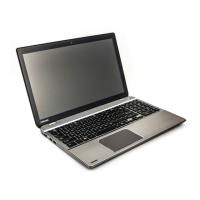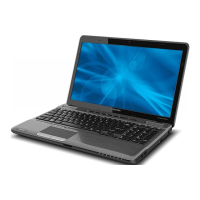
Do you have a question about the Toshiba Satellite P55W-B Series and is the answer not in the manual?
Legal text regarding usage rights and disclaimers.
Details FCC and other regulatory compliance information.
Guidance on appropriate working environments for EMC compliance.
Instructions for proper disposal of products and batteries.
License terms for the OpenSSL toolkit.
License terms for the FreeType Project.
Information on the computer's ENERGY STAR compliance and energy saving features.
Lists required hardware and documentation for initial computer setup.
Basic guidance for initial computer use and safety precautions.
Instructions on how to open the display panel to different angles.
Describes the different operational modes of the computer.
Steps for connecting the AC adaptor for power and charging.
Instructions for turning on the computer for the first time.
Steps for initial operating system setup and configuration.
Instructions for properly shutting down or restarting the computer.
How to use Sleep Mode to pause computer operation and save power.
How to use Hibernation Mode to save the computer's state and power off.
Identifies front components of the computer when the display is closed.
Identifies ports and buttons located on the left side of the computer.
Identifies ports and buttons located on the right side of the computer.
Identifies components located on the back of the computer.
Identifies front components of the computer when the display is open.
Describes the computer's keyboard and touch pad functionality.
Describes the computer's internal hardware components and their functions.
Details the internal rechargeable lithium-ion battery pack.
Legal footnotes regarding Central Processing Unit performance variations.
Information on the computer's storage drives.
Legal footnotes regarding Graphics Processing Unit performance.
Explains the computer and battery charge status indicators.
Instructions for operating the computer in tablet mode.
How to use touch screen gestures like tap, pinch, and rotate.
How to use touch pad gestures like tap, pinch, and scroll.
Overview of the computer's keyboard layout, keys, and indicators.
Describes the function keys (F1-F12) and their modes.
Explains battery types, use, recharging methods, and care.
Instructions for charging the computer's battery.
How to check the remaining battery power and operating time.
Tips and factors affecting battery life and operating time.
Information on memory media slots, types, and usage.
Steps for inserting and safely removing memory media.
Information on enhancing computer capabilities with external displays.
Describes audio control functions and video mode settings.
Overview of pre-installed utilities and applications.
GUI for accessing Toshiba tools and utilities for easier configuration.
Utility to set and manage user and supervisor passwords for computer access.
Utility to customize hardware settings and configure system options.
BIOS setup utility for viewing and changing system settings.
Monitors system functions like power, battery health, and cooling.
Describes unique or advanced features of the computer.
How to use Sleep Mode to pause computer operation and save power.
How to use Hibernation Mode to save the computer's state and power off.
Supplies USB Bus power to ports for charging external devices.
Allows charging USB devices even when the computer is turned off.
Guidelines for identifying and resolving computer problems systematically.
Basic checklist of common issues and simple solutions.
Questions to help identify the cause of a computer problem.
Steps to take when the computer or programs stop responding.
Steps to take if the computer fails to start up.
Troubleshooting power-related issues like overheating or AC adapter problems.
Troubleshooting battery issues such as not charging or powering.
Troubleshooting display panel issues like no display or markings.
Troubleshooting issues related to the hard disk drive.
Troubleshooting touch pad functionality and sensitivity issues.
Troubleshooting sound system issues like no sound or annoying noise.
Information on contacting Toshiba support for technical assistance.
Summarizes the computer's technical specifications.
Specifications for AC power cords and connectors.
Compliance details for Wireless LAN and Bluetooth technologies.
FCC compliance information for Class B digital devices.
Information on radio frequency energy exposure limits.
Legal footnotes regarding Central Processing Unit performance variations.
Legal footnotes regarding memory allocation and display.
Legal footnotes regarding battery life variations.
Definitions of terms used throughout the manual.









